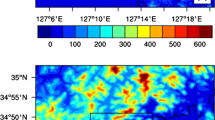Summary
Hourly measurements of surface winds at Sita Eliya (6° 58′ N, 80° 46′ E, 1860 m a.s.l.) located atop the North-South mountain ridge in Sri Lanka were analyzed to investigate the diurnal and seasonal variation in the wind climate. Surface winds are dominated by the monsoon regimes, with Northeasterlies from November to January, Southwesterlies from February to May and Westerlies and Northwesterlies from June to October. Through most of the year, the average wind speed is around 6–8 m/s. However from June to August, it is around 10–14 m/s. Wind in June is gusty due the location of the low-level Easterly jet over Sri Lanka. The wind undergoes a reversal in both zonal and meridional directions in March and November coincident with the migration of the Inter-Tropical Convergence Zone. Notwithstanding the period from May to September being designated as the Southwest monsoon, the wind is from West, South-West-West and North-North-West. During the Southwest monsoon, wind speed during the night is nearly as high as that during the day. This anomalous diurnal variation in wind speeds may be related to orographic influences. The high wind speeds at Sita Eliya, in conjunction with the moderate diurnal and seasonal variability in wind speed, is suitable for wind-energy generation.
Similar content being viewed by others
Author information
Authors and Affiliations
Additional information
Received January 2, 2001 Revised May 26, 2001
Rights and permissions
About this article
Cite this article
Zubair, L. Diurnal and seasonal variation in surface wind at Sita Eliya, Sri Lanka. Theor Appl Climatol 71, 119–127 (2002). https://doi.org/10.1007/s704-002-8212-2
Issue Date:
DOI: https://doi.org/10.1007/s704-002-8212-2




